Proofreading ensures that all spelling, punctuation and grammar are correct and that there are no format and layout issues. It is a final check before publishing your text. Proofreading is a light-touch, final intervention without any significant changes, checking if all the language, formatting and styling decisions made during editing have been consistently reflected in the text. Thus, proofreading is usually the final editorial process of preparing the text for publishing.
Why is it important? | What is included? | What is not included? | Meaning of the name | Proofreading marks | When to hire an editor? | Before hiring an editor | Pricing | Proofreading vs editing | Proofreading vs. copyediting | What next? | Other editing
Ensure there are no punctuation or grammar mistakes
Finalise your text layout and formatting for publication
Remove language and styling inconsistencies
Diagnose word choice problems and typos
Why is proofreading important?
Proofreading is important for two reasons. Firstly, typos, spelling inconsistencies or missing words and punctuation marks may be distracting to the reader and even prompt them to put your book away. So, proofreading makes sure that the story or message of the book can remain the reader’s main focus. Secondly, proofreading ensures that the publication looks professional and may prevent the publishers and readers from assuming that the sloppy-looking text results from the author’s neglect.
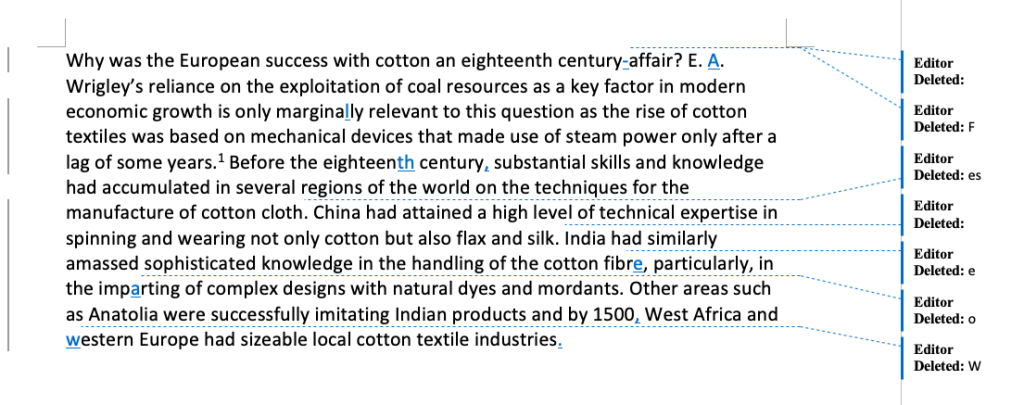
What does proofreading include?
In a nutshell, proofreading eliminates spelling, punctuation, grammatical, capitalisation and numbering errors and fixes styling inconsistencies and formatting issues. In practice, that may include the correction of many, many errors that require an excellent eye for detail. The table below illustrates examples of proofreading interventions in four broad categories: inconsistencies, punctuation issues, formatting and layout issues and word choice and other errors.
Styling and language inconsistencies
- switching between UK and US spelling conventionsinconsistent use of capitalisation or italicising of terms and titlesinconsistent use of numerals (expressed as numbers or written out)switching between single and double quotation marksinconsistent use of tenses
Punctuation issues
- missing commas, apostrophes or periods
- comma splices
- misuse of hyphens, en dashes or em dashes
- ellipsis inserted incorrectly
- quotations left without a closing quotation mark
Formatting and layout issues
- inconsistent indentation
- inconsistent use of formatting styles
- missing or incorrect page or heading numbers
- hyperlinks broken or not leading to the right web pages
- bibliography formatting not adhering to the chosen style guide
- misnumbered captions
- the text referencing wrong figures
Word choice and other errors
- misuse of definite and indefinite articles
- misuse of prepositions
- misspelt words, especially homophones
- missing initial capitalisation at the beginning of a sentence
- typos in the index or bibliography
What is not included in proofreading?
Proofreading focuses on the technicalities of the language: spelling, punctuation, grammatical, capitalisation and numbering errors and fixes styling inconsistencies and formatting issues. Any higher-level problems concerning the content are diagnosed in the preceding editing processes, such as copyediting, line editing or developmental editing. In contrast to these processes, proofreading may not include a style sheet. Usually, when a proofreader starts working on a text, a style sheet is already in place. They will consult it extensively to make sure all the hitherto made language decisions are recorded in the text consistently; they may also add some missing elements.
What is the ‘proof’ in proofreading?
Proofs are the preliminary versions of the texts intended for internal review by the authors and editors. In the context of editing, proofs are often the ultimate or penultimate versions of the text and very little editorial intervention will be made in them. From the perspective of printing and publishing, proofs are the first iteration of a typeset book. In the past, proofs used to be circulated as hard (physical, printed-out) copies. However, nowadays, when proofreading, we work with electronic versions.
What are proofreading marks?
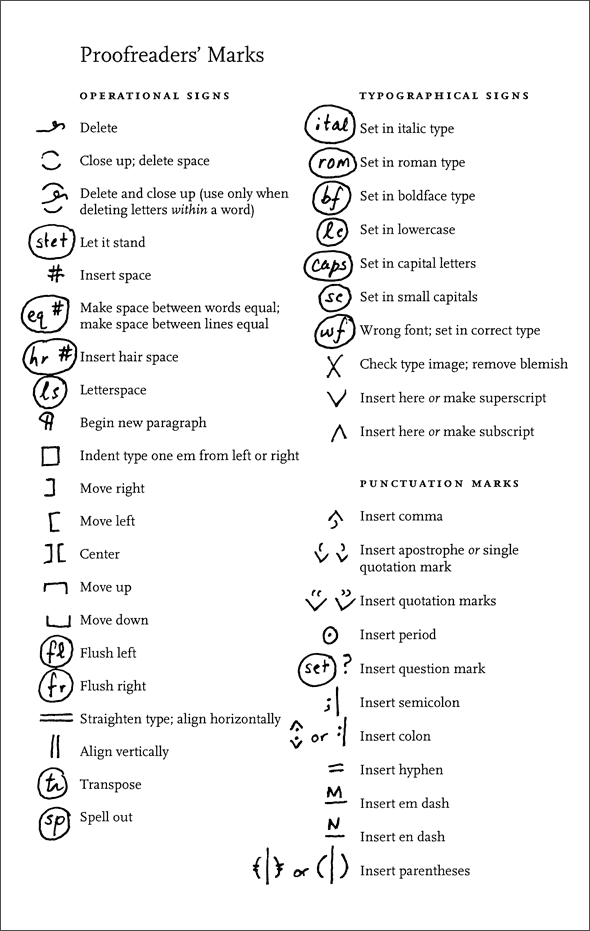
Proofreading marks (sometimes also called proofreaders’ marks) are symbols used by a proofreader when editing a hard copy (a physical, printed-out version of the text). They are coded instructions that most efficiently point out the location of a mistake and an indication of how they should be corrected. They address the technical aspects of the language, such as spelling, punctuation, capitalisation, spacing and layout, but also omissions and repetitions.
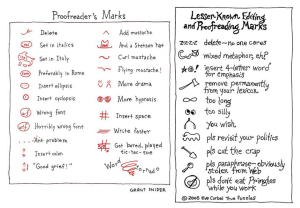
However, there are also humorous takes on proofreading marks, such as those by Grant Snider (left) or Eve Corbel (right). From my perspective as an editor and proofreader, I could certainly appreciate if the ‘word tornado’ has officially entered the proofreading terminology.
When should you hire a proofreader?
Traditionally, proofreading takes place after the manuscript is typeset and circulated in the form of a proof. At this stage, proofreading prevents minor errors from sneaking into print. However, it is also common to have a text proofread before submitting it to the publisher to ensure it presents as professional and refined.
What should you consider when hiring a proofreader?
A competent proofreader should have an excellent command of the language, impeccable attention to detail and, especially if they work with non-fiction, an in-depth understanding of the style guides. To ensure they possess these competencies, it is worth checking their portfolio and client testimonials. Proofreaders will also often offer a free sample edit to showcase their skills. Finally, if they are a member of a professional editorial body, they are likely to have received formal training and follow a code of practice.
Ask the proofreader for a sample edit
Asking the proofreader for a sample edit before signing a contract provides you with an opportunity to check their skillset. It will demonstrate their language expertise and attention to detail.
Ensure they are familiar with the style guide
Academic, scientific, institutional or professional publications usually follow a specific style guide such as Chicago, MLA or APA. They differ in how they present (style) the text and may associate with different subjects. For instance, MLA is often used for writing in the arts, humanities and some social sciences. Thus, it is crucial when ensuring the accuracy and cohesiveness of your text that the proofreader knows well the style guide followed by your text.
Find out about the proofreader’s qualifications
Language is not a static monolith; it evolves with our culture, society, science and technology, changing and developing over time. For this reason, editors and proofreaders, perhaps more than other professional groups, must not neglect their professional development. Joining a professional body that offers a peer network and training is one of the ways that proofreaders may refresh their knowledge. There are global organisations for editors and proofreaders, such as the Editorial Freelancers Association, which offers such opportunities. Regionally, in the UK, there is the Chartered Institute of Editing and Proofreading (CIEP); in North America — ACES: The Society for Editing and the Northwest Editors Guild. So when hiring a proofreader, you might want to check if they are a member of any accredited organisations.
How much should you pay for proofreading?
The current hourly rates for proofreading suggested by the CIEP start from £30.75. Hourly rates in this region will be quoted by professional proofreaders who can justify them with their expertise, training and experience. If you receive a lower estimation for proofreading, the service might likewise represent a lower quality of editing.
Proofreading justifies its price by the competencies required for successfully performing this service: excellent command of the language, impeccable attention to detail and understanding of the style guides.
What is the difference between proofreading and editing?
Proofreading and editing are often used interchangeably; however, they perform different functions in the process of preparing a text for publication. Proofreading focuses on the technicalities of the language: spelling, punctuation, grammatical, capitalisation and numbering errors and fixes inconsistencies and formatting issues. However, it is not concerned with the big-picture issues, such as flow, structure, tone and clarity of every chapter, but also themes and argument or plot developments. These elements are usually addressed during developmental editing. Furthermore, proofreading does not handle any issues with the flow, clarity and vocabulary of the paragraphs and sentences because that is what line editing focuses on. Copyediting has some similarities to proofreading as it also diagnoses language issues, but they are, again, different processes with different purposes.
In sum, if editing is concerned with what the text conveys, proofreading pays the closest attention to how it is conveyed, i.e. the technicalities of the language. Proofreading is also at the end of the editorial process, finalising the preparation of the text for publication.
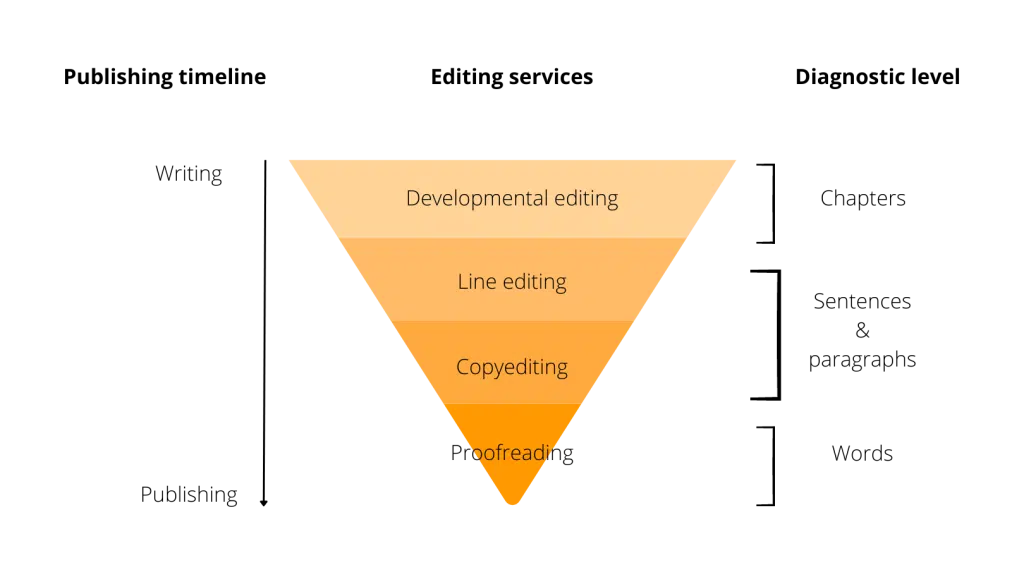
What is the difference between proofreading and copyediting?
Proofreading, in contrast to copyediting, is responsible for cleaning up mechanical inconsistencies overlooked throughout the previous editing process. Proofreaders will not address the flow and cohesiveness of paragraphs and sentences; rather, they work to make sure that words in the text perform their function correctly and consistently. For instance, a copyeditor should check if the figures, tables and illustrations convey the information that the text references and their captions likewise describe their content. A proofreader will be concerned if the captions of figures, tables and illustrations have been numbered correctly.
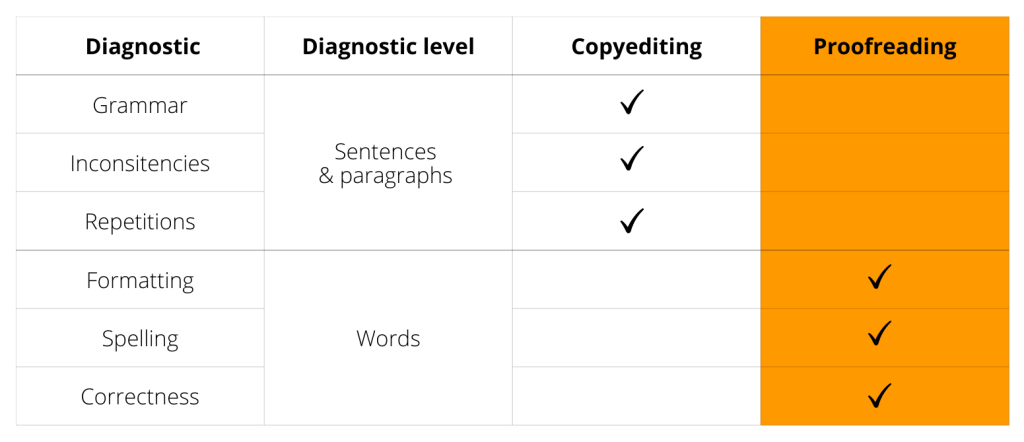
What should happen after proofreading?
Depending on at what stage you decided to have your text proofread (for instance, before submitting it to the publisher or after it was typeset), there are different paths on your editing journey to follow from here.
If your manuscript was proofread post-typesetting and the content is final, then it will go to production so the book can be printed and bound. (Typesetting is the process of arranging a physical or digital version of the manuscript, including letters, symbols and glyphs, onto a page, so it is print-ready.) A quality check will usually take place at this stage, and the advance copies will be distributed to contributors, reviewers and you, the author. Then, it will be time to market and sell the book.
On the other hand, if you decide to have the book proofread before submitting it to the publisher, it will undergo an evaluation process by a commissioning editor. Fingers crossed, it will be accepted!
Can a proofreader do other types of editing?
No, but sometimes — yes. No, because proofreading is usually the final editing stage of a manuscript before it is printed into a book. Yes, because many editors perform different editorial services. So, it might be that the same person has the competencies to proofread but also perform developmental editing.
But note that developmental editing and proofreading require very different skill sets since they work with different aspects of a text. Developmental editing looks at it as a whole and, from this perspective, diagnoses any issues, while proofreading focuses on language technicalities.
Need professional proofreading services at affordable pricing?
Hire me


